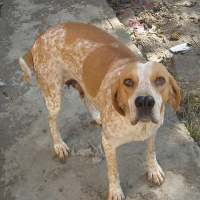Appearance of the Tarsus Catalburun
|
| The Tarsus Çatalburun has a unique appearance. It has what is commonly known as a double or split nose. There are only three known breeds with this characteristic. Its coat is short, flat and stiff to the touch. As there is no official breed standard for the Tarsus Çatalburun, appearance can vary within the breed. Typically, they are very similar to other pointing breeds, with broad, long ears that hang downwards. They are medium-sized dogs weighing an average of 13.5 to 25 kilos. At the shoulder, they measure an average of 43 to 61 centimeters. The Tarsus Çatalburun has been found in several different colors, all with a piebald pattern except for the tricolor, which is black, tan and white. Colors that have been found in the Tarsus Çatalburun are : yellow and white, orange and white, wheat and white, red and white, black and white and tricolor. |
Temperament of the Tarsus Catalburun
|
| Generally speaking, the Tarsus Çatalburun is an even-tempered dog that's very loyal to its family. They are always keen hunters and make excellent hunting companions. It has acute wind and ground tracking abilities, making it ideal for search and rescue, narcotics and police work. It is patient with children when properly trained. The Tarsus Çatalburun can be aggressive towards dogs as it is dominant on its property. Without proper training, he can become aggressive towards other dogs and strangers. This makes him an excellent guard dog, but he needs a solid fence to prevent him from attacking those who approach his property. The Tarsus Çatalburun prefers to live indoors with his family and is generally a quiet breed. It is not ideal for apartment living due to its high energy level. When trained, it complies with its master's commands and enjoys training when positive reinforcement is used. |
Needs and activities of the Tarsus Catalburun
|
| A highly intelligent breed, Tarsus Çatalburun enjoys the mental challenge of training. Wise owners use reward-based training methods to motivate their dogs. When trained regularly, this breed can be extremely obedient and is an excellent option for people interested in agility or other active dog sports. This is a working dog in its own right, and plenty of exercise is essential. When kept as a pet, he should be allowed at least one hour of active off-leash running and chasing, twice a day. If he doesn't, he may become bored and develop antisocial habits, such as digging, chewing or even barking. |
Maintenance of the Tarsus Catalburun
|
| Since the Tarsus Çatalburun is a short-haired dog, its grooming needs are minimal. It does, however, shed slightly throughout the year. Brush him weekly with a natural bristle brush or washcloth to remove dirt and dead hairs and give him a clean, shiny appearance. Removing dead and loose hair prevents it from floating in the air or clinging to your clothes or furniture. This is a high-energy dog with a tendency to get into unpleasant situations. Regular bathing can easily become necessary when engaged in outdoor activities. Don't use harsh shampoos that can dry out his skin. His ears are pendulous, so they need to be kept dry and clean to avoid infection. Check his ears once a week and clean them if necessary. His nails should be trimmed if necessary, usually every two or three weeks. A routine dental plan is necessary to keep teeth and gums healthy. |







 English (United Kingdom)
English (United Kingdom)